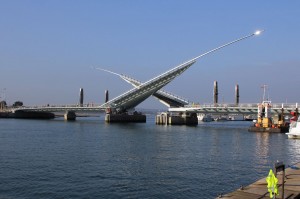 Large hydraulic systems, like those found in bascule bridges, are mostly driven by oil hydraulic systems. These systems tend to require more opening and closing times, which affects traffic flow. One way to better manage the effects on traffic is through an understanding of the dynamic behavior and properties of the hydraulic drive connected to the mechanical system. Using simulation software can help analyze how the hydraulic systems are connected to 3D mechanics.
Large hydraulic systems, like those found in bascule bridges, are mostly driven by oil hydraulic systems. These systems tend to require more opening and closing times, which affects traffic flow. One way to better manage the effects on traffic is through an understanding of the dynamic behavior and properties of the hydraulic drive connected to the mechanical system. Using simulation software can help analyze how the hydraulic systems are connected to 3D mechanics.
The analysis was done on the hydraulic drive system for the new bascule bridge in the town of Poole in Dorset, England. The goal was to determine the best design for the hydraulic system and to ensure that it could handle the stresses that it would experience.
Two hydraulic cylinders drive each of the two leaves of the bridge. Each of the cylinders has a manifold to provide movement control, stability and safety. The cylinders on each side are supported by a hydraulic power pack with one pump per cylinder.
A simulation model was created containing the important components and properties. The modeling was done with the system simulation tool SimulationX. The simulation software allows designers to connect the mechanical components to the hydraulic cylinders in order to test the kinematics of the bridge.
At first, a model considering static loads and rigid mechanics was created. With this model, all known kinematic conditions, masses and external loads were integrated, parameterized and tested.
The mechanical system was modeled with a rigid bearing and a rigid body for one part of the leaf. The leaf was a CAD import element for the complex geometry, the location of the center of mass and the inertia data in the model. The aim with this model was to check the static loads. Part of the analysis involved considering the effect of different external loads, including wind and snow.
The element inner bearing is the real rigid bearing model for the whole leaf. No elasticity or asymmetric bearing loads were considered. For stop and start procedures, friction behavior of the bearing is important. The friction torque in the bearing depends on the load on the bearing. This value is automatically calculated in the 3D model. The friction torque was considered directly in the bearing model from the normal load, the friction coefficient and bearing radius.
The power pack model considers the behavior of the two pumps with adjustable flow and pressure control, including pressure limitation by a safety valve. The directional valve models consider the flow behavior and switching time.
The control block delivers discrete signals. Behind this block is a state machine described with the internal state chart editor. The outputs of the control block were handled in separate blocks for the dynamic behavior of different devices. Pump speed is settled up from the beginning. The pumps start to rotate and the displacement is at a minimum value of 5%. After two seconds, the pressure relief valve is actuated and after another second, if the pressure has reached the setting value, the directional valves are switched. After that the pumps are activated to increase the displacement volume. In principle, different setting values for the pump control are possible. These values can be changed depending on the angle at the bearing.
If the pumps are running, the pressure relief valve will be energized to check the operating pressure. After that the directional valves are switched to the position regarding the direction of operation. The speed is controlled by the pump displacement control.
The components of the power pack and the components of the manifold are modeled with standard elements or as detailed, user-defined structures. The model for the directional control valve is integrated in the system model. Each solenoid is energized separately considering dynamic effects. The dynamic blocks “limitedPT1” and “limitedPT2” consider the dynamic behavior of the valves, mainly a slope time for opening and closing.
The installed throttle valves between the pilot stage and main stage adjust slope time. The model runs with equal values for both valves. The control signals come from the controller as a discrete value (0/1). The dynamic behavior of both directional valves is identical.
One challenge was the model of the counter balance valve. It was not sufficient to use a simple element so the valve was modeled with all mechanical subsystems and hydraulic resistance networks.
The valve contains a nozzle to limit the X port control pressure. Simulations have shown the need to increase the closing time in emergency cases.
Using the simulation model, it was shown that the drive system worked well in different situations, including emergency stops. 
Hunger Hydraulics
Filed Under: Fluid Power World Magazine Articles